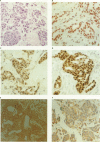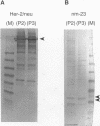Abstract
Xenografts originated from human tumours offer the most appropriate research material for in vivo experimental research. However, primary human breast carcinomas are difficult to grow when transplanted in athymic mice: tumour take is less than 15%. Recently, we have achieved 60% tumour take by injecting tumour cell suspensions mixed with Matrigel. Human breast xenografts originated from primary breast carcinoma also frequently show the potential to metastasize spontaneously. In the present study, we generated a human breast carcinoma xenograft line (UISO-BCA-NMT-18) that shows 100% tumorigenicity and 80-100% lung metastasis when transplanted s.c. in athymic mice. We have studied in detail the characteristics of the xenograft and the patient's tumour from which the xenograft line originated. Both the xenograft and the patient's tumour showed intense staining for mutant p53 nuclear protein, and high expression of U-PA, PAI and u-PAR. In vivo growth of the xenograft is stimulated by exogenous supplementation of oestrogen. This xenograft is continuously growing in mice and has shown 80-100% metastasis for the last three successive in vivo passages. This well-characterized, oestrogen-responsive, metastatic breast carcinoma xenograft line will provide excellent research material for metastasis-related research.
Full text
PDF

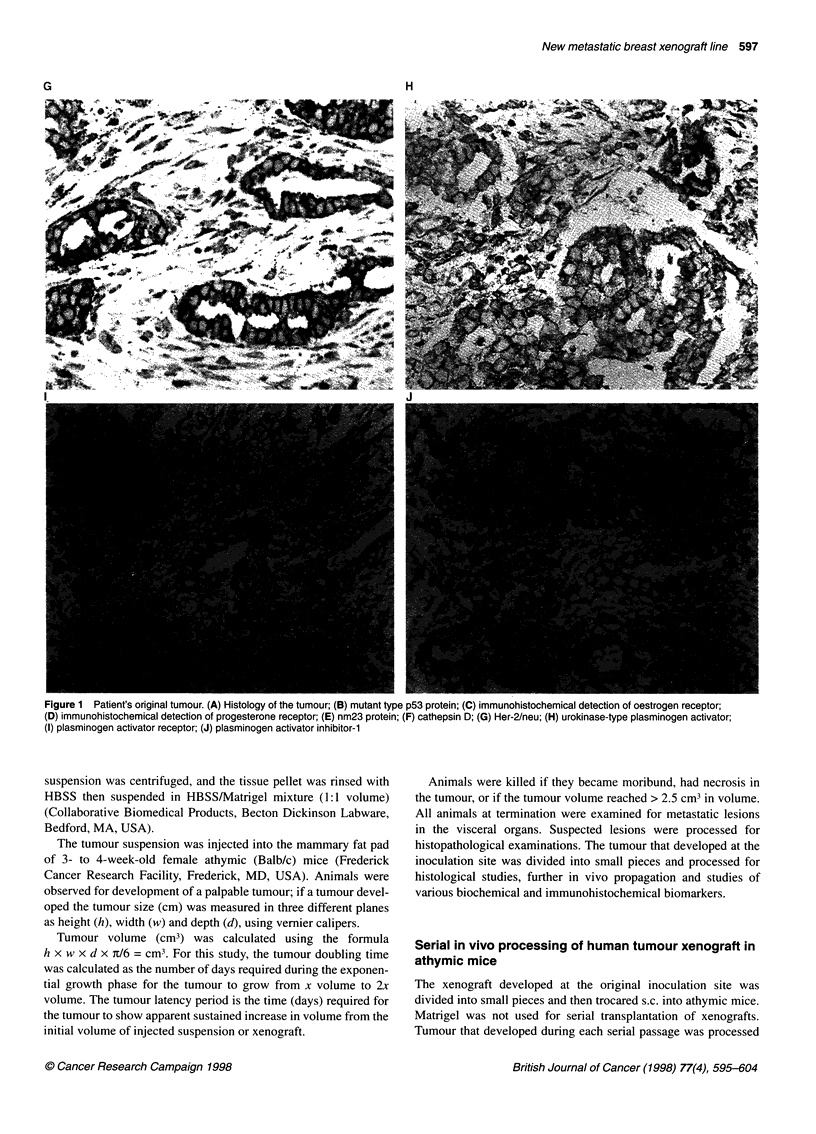
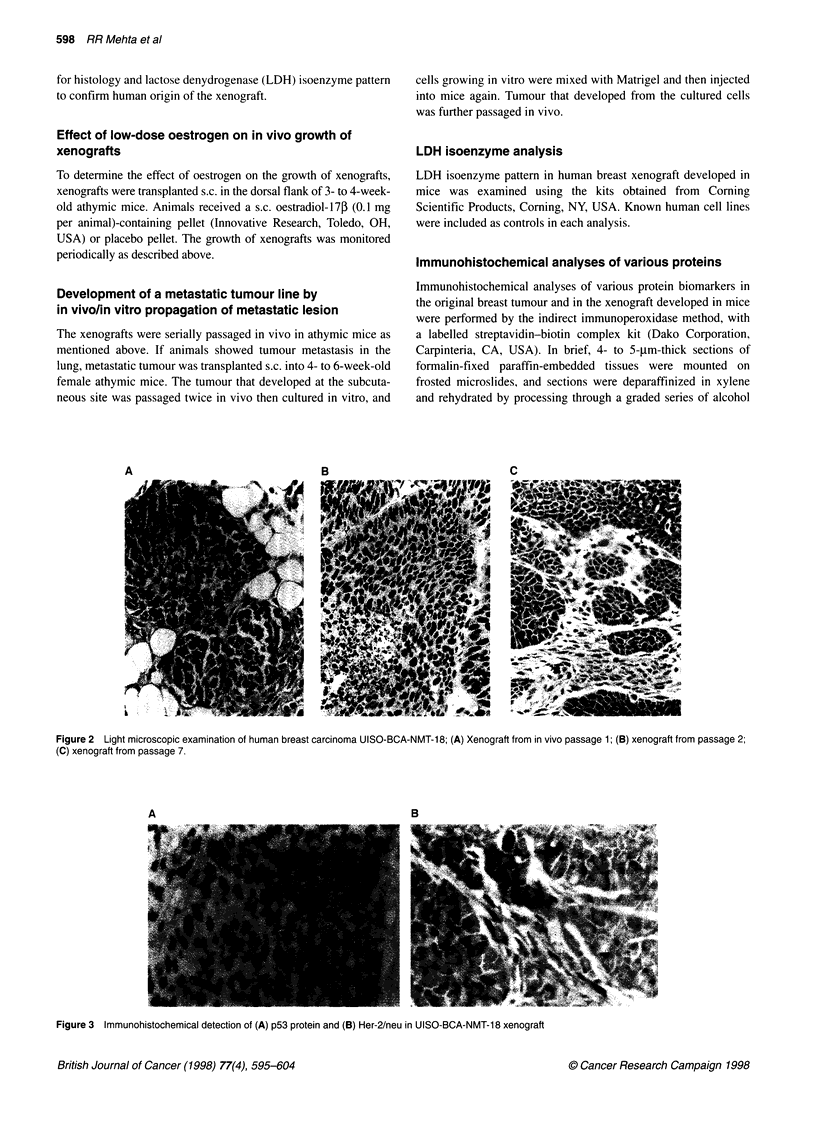
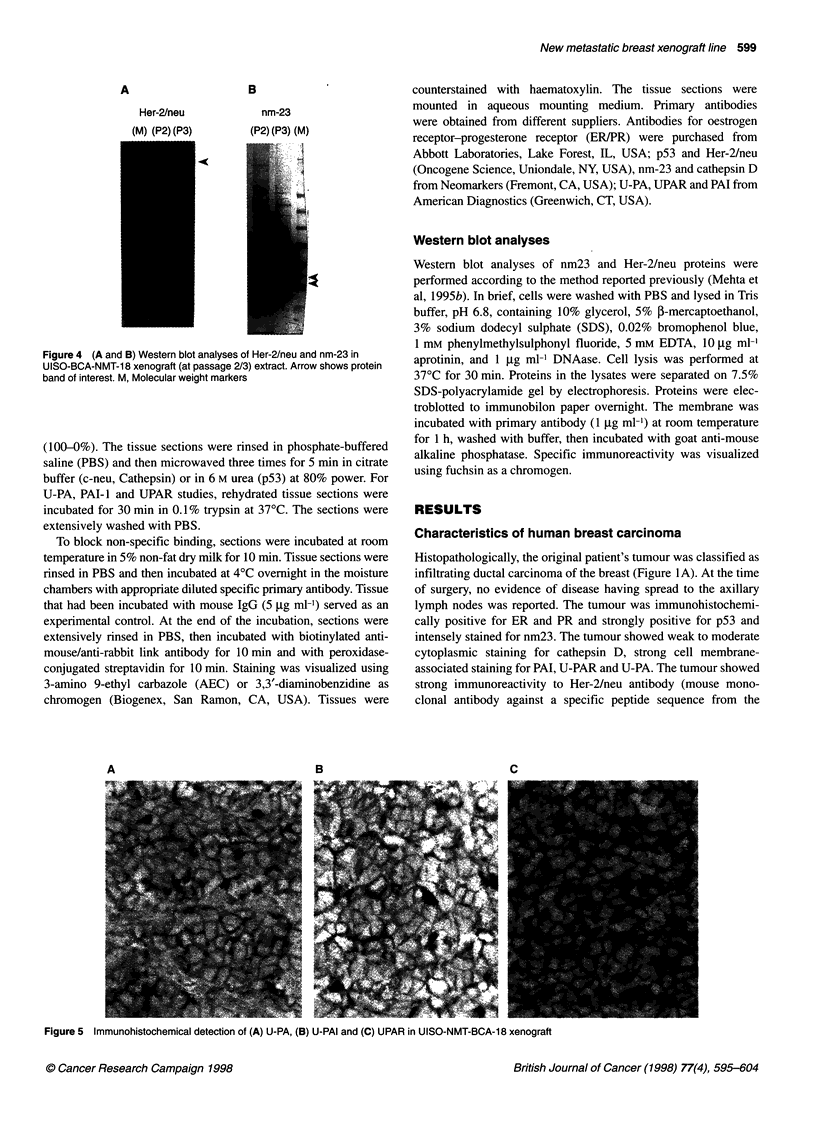

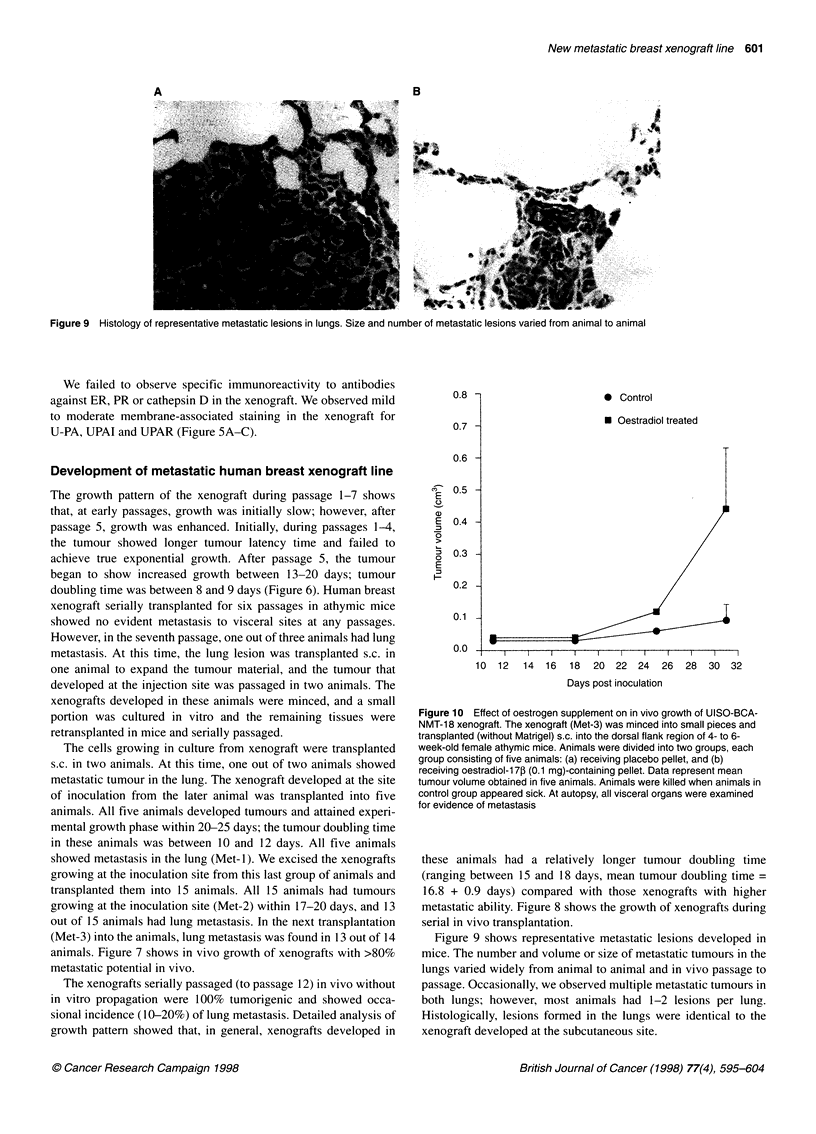
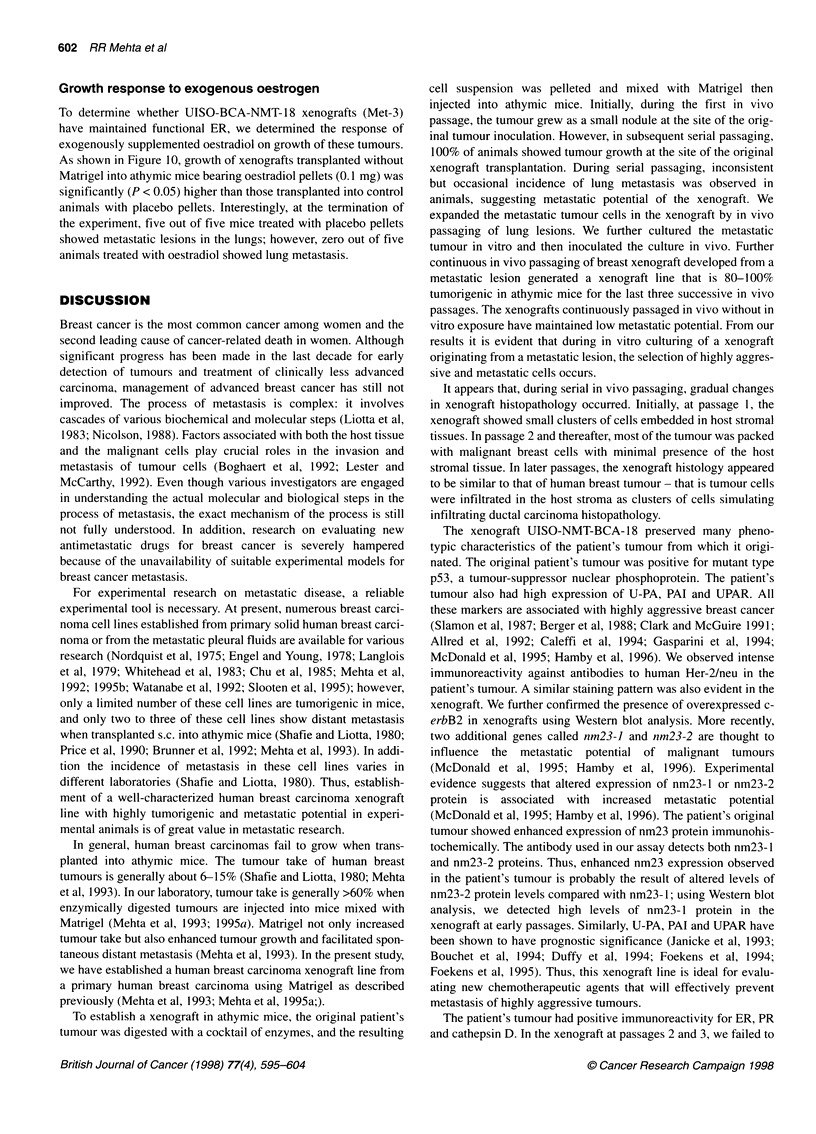
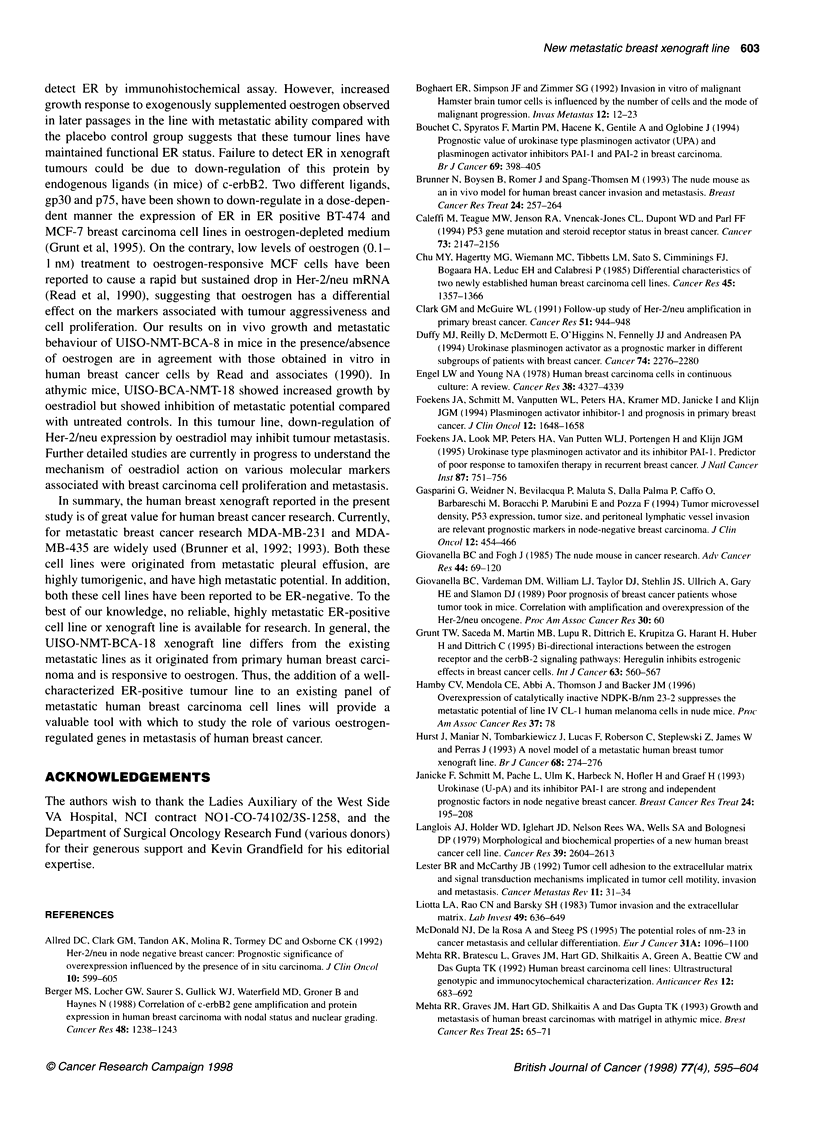
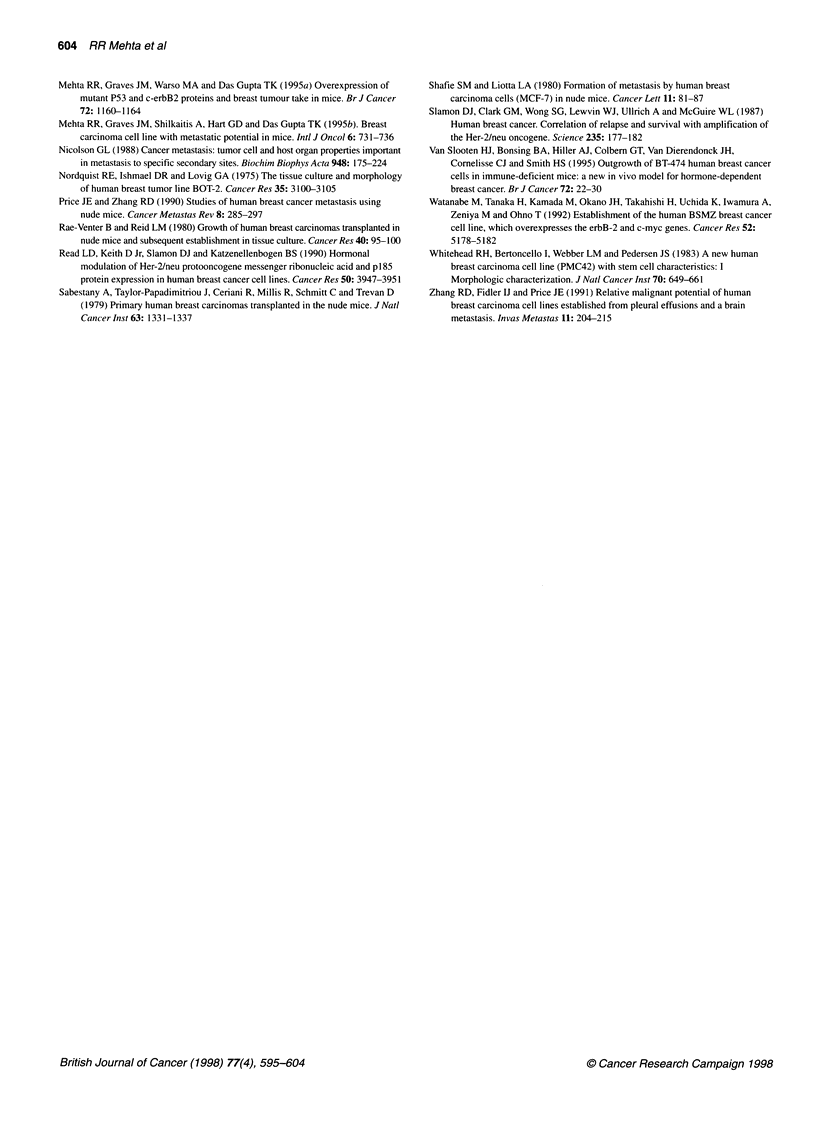
Images in this article
Selected References
These references are in PubMed. This may not be the complete list of references from this article.
- Allred D. C., Clark G. M., Tandon A. K., Molina R., Tormey D. C., Osborne C. K., Gilchrist K. W., Mansour E. G., Abeloff M., Eudey L. HER-2/neu in node-negative breast cancer: prognostic significance of overexpression influenced by the presence of in situ carcinoma. J Clin Oncol. 1992 Apr;10(4):599–605. doi: 10.1200/JCO.1992.10.4.599. [DOI] [PubMed] [Google Scholar]
- Berger M. S., Locher G. W., Saurer S., Gullick W. J., Waterfield M. D., Groner B., Hynes N. E. Correlation of c-erbB-2 gene amplification and protein expression in human breast carcinoma with nodal status and nuclear grading. Cancer Res. 1988 Mar 1;48(5):1238–1243. [PubMed] [Google Scholar]
- Boghaert E. R., Simpson J. F., Zimmer S. G. Invasion in vitro of malignant hamster brain tumor cells is influenced by the number of cells and the mode of malignant progression. Invasion Metastasis. 1992;12(1):12–23. [PubMed] [Google Scholar]
- Bouchet C., Spyratos F., Martin P. M., Hacène K., Gentile A., Oglobine J. Prognostic value of urokinase-type plasminogen activator (uPA) and plasminogen activator inhibitors PAI-1 and PAI-2 in breast carcinomas. Br J Cancer. 1994 Feb;69(2):398–405. doi: 10.1038/bjc.1994.74. [DOI] [PMC free article] [PubMed] [Google Scholar]
- Brünner N., Boysen B., Rømer J., Spang-Thomsen M. The nude mouse as an in vivo model for human breast cancer invasion and metastasis. Breast Cancer Res Treat. 1993;24(3):257–264. doi: 10.1007/BF01833265. [DOI] [PubMed] [Google Scholar]
- Caleffi M., Teague M. W., Jensen R. A., Vnencak-Jones C. L., Dupont W. D., Parl F. F. p53 gene mutations and steroid receptor status in breast cancer. Clinicopathologic correlations and prognostic assessment. Cancer. 1994 Apr 15;73(8):2147–2156. doi: 10.1002/1097-0142(19940415)73:8<2147::aid-cncr2820730820>3.0.co;2-5. [DOI] [PubMed] [Google Scholar]
- Chu M. Y., Hagerty M. G., Wiemann M. C., Tibbetts L. M., Sato S., Cummings F. J., Bogaars H. A., Leduc E. H., Calabresi P. Differential characteristics of two newly established human breast carcinoma cell lines. Cancer Res. 1985 Mar;45(3):1357–1366. [PubMed] [Google Scholar]
- Clark G. M., McGuire W. L. Follow-up study of HER-2/neu amplification in primary breast cancer. Cancer Res. 1991 Feb 1;51(3):944–948. [PubMed] [Google Scholar]
- Duffy M. J., Reilly D., McDermott E., O'Higgins N., Fennelly J. J., Andreasen P. A. Urokinase plasminogen activator as a prognostic marker in different subgroups of patients with breast cancer. Cancer. 1994 Oct 15;74(8):2276–2280. doi: 10.1002/1097-0142(19941015)74:8<2276::aid-cncr2820740811>3.0.co;2-7. [DOI] [PubMed] [Google Scholar]
- Engel L. W., Young N. A. Human breast carcinoma cells in continuous culture: a review. Cancer Res. 1978 Nov;38(11 Pt 2):4327–4339. [PubMed] [Google Scholar]
- Foekens J. A., Look M. P., Peters H. A., van Putten W. L., Portengen H., Klijn J. G. Urokinase-type plasminogen activator and its inhibitor PAI-1: predictors of poor response to tamoxifen therapy in recurrent breast cancer. J Natl Cancer Inst. 1995 May 17;87(10):751–756. doi: 10.1093/jnci/87.10.751. [DOI] [PubMed] [Google Scholar]
- Foekens J. A., Schmitt M., van Putten W. L., Peters H. A., Kramer M. D., Jänicke F., Klijn J. G. Plasminogen activator inhibitor-1 and prognosis in primary breast cancer. J Clin Oncol. 1994 Aug;12(8):1648–1658. doi: 10.1200/JCO.1994.12.8.1648. [DOI] [PubMed] [Google Scholar]
- Gasparini G., Weidner N., Bevilacqua P., Maluta S., Dalla Palma P., Caffo O., Barbareschi M., Boracchi P., Marubini E., Pozza F. Tumor microvessel density, p53 expression, tumor size, and peritumoral lymphatic vessel invasion are relevant prognostic markers in node-negative breast carcinoma. J Clin Oncol. 1994 Mar;12(3):454–466. doi: 10.1200/JCO.1994.12.3.454. [DOI] [PubMed] [Google Scholar]
- Giovanella B. C., Fogh J. The nude mouse in cancer research. Adv Cancer Res. 1985;44:69–120. doi: 10.1016/s0065-230x(08)60026-3. [DOI] [PubMed] [Google Scholar]
- Grunt T. W., Saceda M., Martin M. B., Lupu R., Dittrich E., Krupitza G., Harant H., Huber H., Dittrich C. Bidirectional interactions between the estrogen receptor and the cerbB-2 signaling pathways: heregulin inhibits estrogenic effects in breast cancer cells. Int J Cancer. 1995 Nov 15;63(4):560–567. doi: 10.1002/ijc.2910630417. [DOI] [PubMed] [Google Scholar]
- Hurst J., Maniar N., Tombarkiewicz J., Lucas F., Roberson C., Steplewski Z., James W., Perras J. A novel model of a metastatic human breast tumour xenograft line. Br J Cancer. 1993 Aug;68(2):274–276. doi: 10.1038/bjc.1993.327. [DOI] [PMC free article] [PubMed] [Google Scholar]
- Jänicke F., Schmitt M., Pache L., Ulm K., Harbeck N., Höfler H., Graeff H. Urokinase (uPA) and its inhibitor PAI-1 are strong and independent prognostic factors in node-negative breast cancer. Breast Cancer Res Treat. 1993;24(3):195–208. doi: 10.1007/BF01833260. [DOI] [PubMed] [Google Scholar]
- Langlois A. J., Holder W. D., Jr, Iglehart J. D., Nelson-Rees W. A., Wells S. A., Jr, Bolognesi D. P. Morphological and biochemical properties of a new human breast cancer cell line. Cancer Res. 1979 Jul;39(7 Pt 1):2604–2613. [PubMed] [Google Scholar]
- Liotta L. A., Rao C. N., Barsky S. H. Tumor invasion and the extracellular matrix. Lab Invest. 1983 Dec;49(6):636–649. [PubMed] [Google Scholar]
- MacDonald N. J., de la Rosa A., Steeg P. S. The potential roles of nm23 in cancer metastasis and cellular differentiation. Eur J Cancer. 1995 Jul-Aug;31A(7-8):1096–1100. doi: 10.1016/0959-8049(95)00152-9. [DOI] [PubMed] [Google Scholar]
- Mehta R. R., Bratescu L., Graves J. M., Hart G. D., Shilkaitis A., Green A., Beattie C. W., Das Gupta T. K. Human breast carcinoma cell lines: ultrastructural, genotypic, and immunocytochemical characterization. Anticancer Res. 1992 May-Jun;12(3):683–692. [PubMed] [Google Scholar]
- Mehta R. R., Graves J. M., Hart G. D., Shilkaitis A., Das Gupta T. K. Growth and metastasis of human breast carcinomas with Matrigel in athymic mice. Breast Cancer Res Treat. 1993;25(1):65–71. doi: 10.1007/BF00662402. [DOI] [PubMed] [Google Scholar]
- Mehta R. R., Graves J. M., Warso M. A., Das Gupta T. K. Overexpression of mutant p53 and c-erbB-2 proteins and breast tumour take in mice. Br J Cancer. 1995 Nov;72(5):1160–1164. doi: 10.1038/bjc.1995.480. [DOI] [PMC free article] [PubMed] [Google Scholar]
- Nicolson G. L. Cancer metastasis: tumor cell and host organ properties important in metastasis to specific secondary sites. Biochim Biophys Acta. 1988 Nov 15;948(2):175–224. doi: 10.1016/0304-419x(88)90010-8. [DOI] [PubMed] [Google Scholar]
- Nordquist R. E., Ishmael D. R., Lovig C. A., Hyder D. M., Hoge A. F. The tissue culture and morphology of human breast tumor cell line BOT-2. Cancer Res. 1975 Nov;35(11 Pt 1):3100–3105. [PubMed] [Google Scholar]
- Price J. E., Zhang R. D. Studies of human breast cancer metastasis using nude mice. Cancer Metastasis Rev. 1990 Feb;8(4):285–297. doi: 10.1007/BF00052605. [DOI] [PubMed] [Google Scholar]
- Rae-Venter B., Reid L. M. Growth of human breast carcinomas in nude mice and subsequent establishment in tissue culture. Cancer Res. 1980 Jan;40(1):95–100. [PubMed] [Google Scholar]
- Read L. D., Keith D., Jr, Slamon D. J., Katzenellenbogen B. S. Hormonal modulation of HER-2/neu protooncogene messenger ribonucleic acid and p185 protein expression in human breast cancer cell lines. Cancer Res. 1990 Jul 1;50(13):3947–3951. [PubMed] [Google Scholar]
- Slamon D. J., Clark G. M., Wong S. G., Levin W. J., Ullrich A., McGuire W. L. Human breast cancer: correlation of relapse and survival with amplification of the HER-2/neu oncogene. Science. 1987 Jan 9;235(4785):177–182. doi: 10.1126/science.3798106. [DOI] [PubMed] [Google Scholar]
- Watanabe M., Tanaka H., Kamada M., Okano J. H., Takahashi H., Uchida K., Iwamura A., Zeniya M., Ohno T. Establishment of the human BSMZ breast cancer cell line, which overexpresses the erbB-2 and c-myc genes. Cancer Res. 1992 Oct 1;52(19):5178–5182. [PubMed] [Google Scholar]
- Whitehead R. H., Bertoncello I., Webber L. M., Pedersen J. S. A new human breast carcinoma cell line (PMC42) with stem cell characteristics. I. Morphologic characterization. J Natl Cancer Inst. 1983 Apr;70(4):649–661. [PubMed] [Google Scholar]
- Zhang R. D., Fidler I. J., Price J. E. Relative malignant potential of human breast carcinoma cell lines established from pleural effusions and a brain metastasis. Invasion Metastasis. 1991;11(4):204–215. [PubMed] [Google Scholar]
- van Slooten H. J., Bonsing B. A., Hiller A. J., Colbern G. T., van Dierendonck J. H., Cornelisse C. J., Smith H. S. Outgrowth of BT-474 human breast cancer cells in immune-deficient mice: a new in vivo model for hormone-dependent breast cancer. Br J Cancer. 1995 Jul;72(1):22–30. doi: 10.1038/bjc.1995.271. [DOI] [PMC free article] [PubMed] [Google Scholar]



